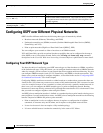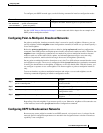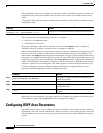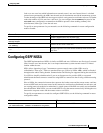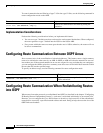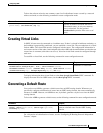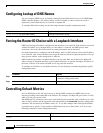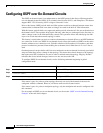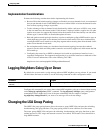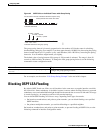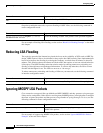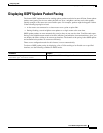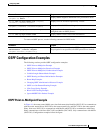
Configuring OSPF
Configuring OSPF over On-Demand Circuits
IPC-234
Cisco IOS IP Configuration Guide
Configuring OSPF over On-Demand Circuits
The OSPF on-demand circuit is an enhancement to the OSPF protocol that allows efficient operation
over on-demand circuits like ISDN, X.25 switched virtual circuits (SVCs), and dialup lines. This feature
supports RFC 1793, Extending OSPF to Support Demand Circuits.
Prior to this feature, OSPF periodic hello and LSA updates would be exchanged between routers that
connected the on-demand link, even when no changes occurred in the hello or LSA information.
With this feature, periodic hellos are suppressed and the periodic refreshes of LSAs are not flooded over
the demand circuit. These packets bring up the link only when they are exchanged for the first time, or
when a change occurs in the information they contain. This operation allows the underlying data link
layer to be closed when the network topology is stable.
This feature is useful when you want to connect telecommuters or branch offices to an OSPF backbone
at a central site. In this case, OSPF for on-demand circuits allows the benefits of OSPF over the entire
domain, without excess connection costs. Periodic refreshes of hello updates, LSA updates, and other
protocol overhead are prevented from enabling the on-demand circuit when there is no “real” data to
send.
Overhead protocols such as hellos and LSAs are transferred over the on-demand circuit only upon initial
setup and when they reflect a change in the topology. This means that critical changes to the topology
that require new SPF calculations are sent in order to maintain network topology integrity. Periodic
refreshes that do not include changes, however, are not sent across the link.
To configure OSPF for on-demand circuits, use the following commands beginning in global
configuration mode:
If the router is part of a point-to-point topology, then only one end of the demand circuit must be
configured with this command. However, all routers must have this feature loaded.
If the router is part of a point-to-multipoint topology, only the multipoint end must be configured with
this command.
For an example of OSPF over an on-demand circuit, see the section “OSPF over On-Demand Routing
Example” at the end of this chapter.
Command Purpose
Step 1
Router(config)# router ospf process-id
Enables OSPF operation.
Step 2
Router(config)# interface interface-type
interface-number
Enters interface configuration mode.
Step 3
Router(config-if)# ip ospf demand-circuit
Configures OSPF on an on-demand circuit.



